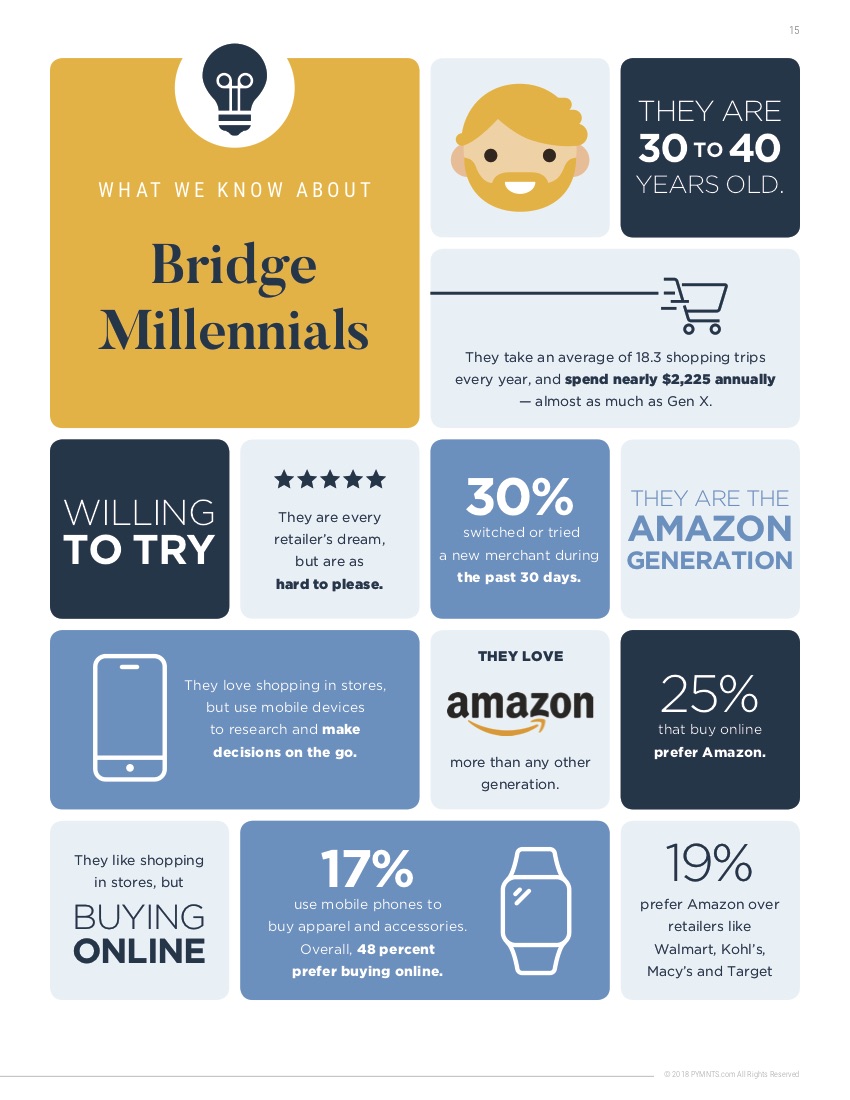Bridge Millennials And The Threat To Physical Retail

Sometimes it pays to follow the scent.
Each quarter for about the last 18 months, we’ve asked 4,000 consumers to tell us why they shopped in the physical store and how the physical store fit into their overall shopping pattern.
Over that time, we examined four retail segments — mass merchants/department stores, grocery, health/beauty and apparel/accessories — and pushed an online survey to those consumers after they made a purchase and left the store.
This work was done with the support of Worldpay and was intended to gain greater clarity into consumers’ expectations of an “omnichannel” experience across the digital and physical retail touchpoints. More importantly, we wanted to understand how consumers felt the retailers they shopped measured up.
The story, as we’ve reported, was that consumers didn’t think those retailers were up to snuff.
Less than half of all consumers we studied over that period of time reported being satisfied with how well retailers followed them across physical and digital channels.
The gap was particularly acute when it came to something consumers regarded as a no-brainer in today’s mobile/digital world: knowing them and their purchase history regardless of the channel they shopped.
Personalizing the offer and the experience was key, and it was where consumers expressed the most disappointment in today’s retail experience. It’s why so many consumers are shifting online, and to a small set of retailers led by Amazon and Walmart, to do their shopping.
But something else piqued our curiosity as we looked at tens of thousands of data points — with a hunch that the shopping and spending behaviors of 24-year-olds were very different from 34-year-olds — even though they were both lumped together and labeled “millennials.”
That’s when we discovered a new demographic cohort: the first real generation of connected consumer with spending power. We called them Bridge Millennials.
At 30 to 40 years of age, they are younger than Gen X-ers but older than most millennials.
They are affluent and well-educated.
They are settling into more stable careers and are earning more money.
They are spending their money using connected devices to guide their shopping decisions — from the products they buy to the stores at which they shop.
And, in that order.
We believe the Bridge Millennial is the bellwether for how connected commerce will evolve over the next five to 10 years. We also think comprehending their behaviors today is critical for retailers to understand for three reasons.
They are the consumers whose expectations of omnichannel and omnicommerce are the highest.
They are the shoppers whose connected devices are the intermediaries they look to first for what they buy and from whom they buy it.
And they are the cohort of shoppers who are reviving a shopping trend retailers thought they might have left in their rearview mirror: showrooming.
Follow the Scent
Our omnichannel work uncovered three consumer shopping personas.
The Digital Shopper — one who characterizes herself as making half or more of her purchases through digital channels. Forty-four percent of Digital Shoppers report having a college degree and a household income of $76,000 a year. At 42, she is the youngest of the three persona groups. As a point of reference, the Census Bureau reports that roughly a third of U.S. adults have a college education.
The Any Channel Shopper — one who characterizes herself as dividing her spend between physical and retail channels. This group is roughly the same age as the Digital Shopper and reports an annual household income of $70,000 a year. Twenty-two (22) percent report having a college degree.
The Brick-and-Mortar Shopper — one who characterizes herself as conducting half or more of her spend in a physical store. This persona reports an annual household income of $64,000, and 13 percent report having a college degree. This group is two years older than their Digital and Any Channel shopper counterparts.
Individually and collectively, these shopping behaviors tell a slightly different story than what Census Bureau numbers might have us believe.
Fewer than half of all shoppers said the majority of their spend was done exclusively at a physical store.
Most people divided their spend between physical and online channels, and the degree to which they did varied by retail segment. But even in a segment once considered the bastion of physical store purchasing — grocery — shoppers reported using both digital and physical channels.
Forty-one (41) percent of shoppers reported that brick-and-mortar buying dominated their grocery spend. For those of you doing the math at home, that means 59 percent used both digital and physical shopping channels when buying grocery products — think food plus things like paper towels, laundry detergent, garbage bags, etc.
That, I think, is an amazing and remarkable development.
The other surprise, though, was apparel, where only a third of respondents reported doing most of their shopping in a physical store.
There’s something else.
As part of our omnichannel study, we asked consumers who just came out of a physical store whether they knew what they wanted to buy before walking into the store to buy it.
In almost every retail segment, the vast majority of consumers said they did — and for one of two reasons: They had either shopped there before and knew what to expect and/or they had consulted their mobile phones or computers first to determine whether that store did have the item or items they wanted to buy before going there.
There was one outlier: apparel.
Sixty-five (65) percent of all shoppers and 68 percent of digital shoppers said they didn’t really know what they wanted before walking into a store. Their visit was to inspect and/or to look at the merchandise they found online before making a purchase.
We wanted to know what happened when they got there.
Stores as Showrooms — Redux
It’s no secret that brick-and-mortar clothing retailers are under intense pressure today.
The consumer’s taste in clothing has changed, and that has changed how people shop for clothes.
Business casual Fridays have become all casual and every day. Men and women who once bought “work” clothes and “casual” clothes are now buying casual clothes that do double duty. Athleisure has emerged as a work/casual/workout crossover trend.
That change has made it easier for consumers to buy their clothes online and not spend a lot of money when they buy them. Black yoga pants and fleece hoodies aren’t that hard to buy online. They’re also a lot cheaper than buying a nice sports jacket, collared shirt and pants or pencil skirt, blouse and blazer. “Restocks” of items like jeans and T-shirts, once people have found what works for them, are also an easy point, click and ship away.
For those with more sartorial tastes, subscription players like Indochino, Bonobos, Trunk Club, Stitch Fix, Rent the Runway and Amazon Fashion — along with fashion-forward eTailers like Revolve and FRWRD — have emerged to make it easy to buy the latest fashions without spending much (or any) time in a store.
That’s put lots of pressure on brick-and-mortar retailers to figure out what’s next.
So, in early March, the PYMNTS team conducted a new study of more than 2,000 consumers to understand how they shop and buy clothes — and the role of the physical store in those buying decisions. If more than three-quarters of consumers said they walked into a physical store to look at something before buying it, we wanted to know if they also walked out having made a purchase.
And this time, instead of just asking people to check a box with age ranges that map to Census Bureau-reporting age bands, we asked people to tell us exactly how old they were.
That’s when we discovered the power of the Bridge Millennial.
The Bridge to the Future of Retail?
When it comes to clothing and accessories, here’s the Bridge Millennial punchline:
They buy a lot: Eighteen purchases a year, second only to millennials at 19 purchases a year.
They spend a lot: $2,225 a year, second only to Gen X-ers at $2,367 a year.
They prefer debit to credit and PayPal much more than store cards. Bridge Millennials use debit more than any other shopping cohort when making purchases and credit less than millennials and only a smidge more than Gen X. They use PayPal only slightly less than millennials do — and much more than baby boomers and Gen X. Store cards barely register.
They shop using their mobile phones a lot: Seventeen (17) percent of Bridge Millennials say they use mobile phones to make clothing and accessories purchases — more than millennials at 15.9 percent.
They are also the most fickle: Nearly a third, 30 percent, of Bridge Millennials have switched away from or tried a new merchant in the last 30 days compared to 21 percent for other shopping cohorts.
They use stores as showrooms a lot: Fourteen (14) percent of Bridge Millennials say they use retail stores to look at things but not to buy them, compared to 11 percent for other groups.
They like buying online a lot: Nearly half, 48 percent, of Bridge Millennials report a preference for making their clothing and accessories purchases online compared to 40 percent of other shoppers. A quarter of Bridge Millennials report Amazon as their retailer of preference when they do make purchases of clothing online.
It’s not that Bridge Millennials avoid going into the physical store — they do. It’s just that they don’t always walk out of those stores with a purchase in their hands.
Brick-and-mortar retailers, no doubt, understand this too.
Many are making investments in creating in-store experiences that will appeal to this new generation of shopper: fashion shows, trunk shows, personal appearances by designers and more.
That’s not what these Bridge Millennials say they want.
This connected consumer wants technology — and more of it — to make their shopping experiences in the physical store as efficient and easy as buying online. This set of shoppers reports the ability to scan items and/or use kiosks in the store to query product information, inventory availability or check out is what they want.
Personal shoppers in-store? Not really.
Chatbots? Nope.
A personal assistant who is virtual? Yes.
Roughly 5 percent (4.8 percent to be precise) of Bridge Millennials report using a voice assistant when making purchases of clothing and/or deciding what to buy and where to buy it — twice as much as other groups.
Above all, this generation of shopper wants the retailer to know who they are when they walk into the store so services, products and promotions can be tailored to their preferences and reflect past purchases.
And delivered via their mobile devices.
Convenience is what drives the shopping decisions for the Bridge Millennial, followed by having the product they want to buy. Followed by price. Rewards and loyalty schemes are way, way down the list.
What’s Next?
There’s a glass half full and a glass half empty story here with respect to how physical store retailers should adapt their strategies to serve the Bridge Millennial consumer — at least when it comes to clothes and accessories.
The glass half empty says: game over, physical retailer.
This connected consumer is in charge, and she knows she’s the boss.
She doesn’t need the physical store to be the intermediary between her and what she wants to buy. For this shopper, physical stores have given way to physical devices like phones and speakers and software and apps that make it easy for her to discover what she wants to buy and then buy it — using one of the three payments methods she likes best; debit, credit or PayPal — on her own terms.
This generation of shopper is opportunistic — using the physical store to inspect the things she’s found online. Maybe she’ll buy it there and maybe she won’t, but that’s not up to the store she’s standing in to decide. And maybe not even to influence her.
Convenience and product selection is what she craves, and physical retail doesn’t really check those boxes for her anymore. Online does, Amazon does increasingly, and that is the standard by which this cohort of shoppers will judge every other retailer they encounter — online and offline.
The glass half full says physical retail still has a shot.
Amazon may be the favorite retailer for 25 percent of Bridge Millennials (against 14 percent of all shoppers), but most consumers say their favorite retailer is a lot of them.
Product selection is important to consumers, and they like to shop with a variety of merchants to get what they want. And, for clothes at least, seeing and touching and trying something on is still important. Thirty-eight (38) percent of Bridge Millennials go to a store and then buy in a store, and that’s a start. Using technology to identify and influence those conversion opportunities for this highly connected consumer can turn a visit into a sale and a repeat customer.
What seems clear is that the Bridge Millennial’s shopping behaviors and patterns, like her baby boomer parents and Gen X siblings before her, are already well-established. Clothing trends may come and go, but her digital shopping habits seem pretty predictable as more connected devices deliver more opportunities for Bridge Millennials and brands to connect.
And not necessarily in the physical store.
There’s no doubt the Bridge Millennial will drive the reinvention of retail — she has the spending power, the appetite to spend money and the interest in shopping a large swath of retailers to do it.
The big question is whether retailers will be as quick to master the technology that’s now second nature to this important retail segment.


